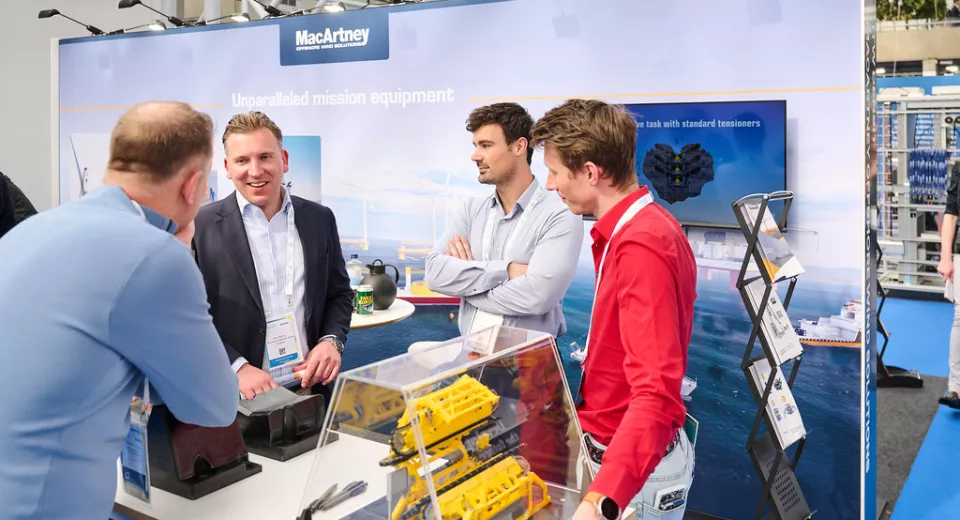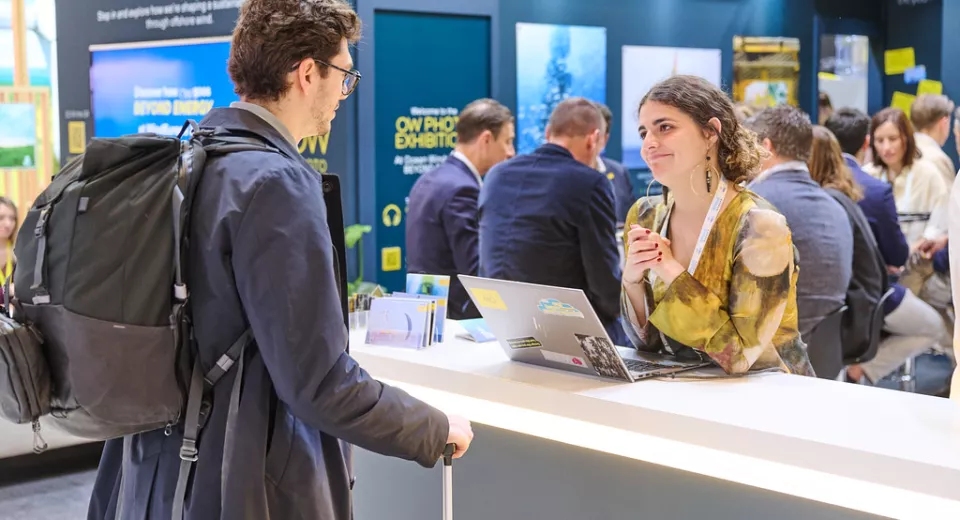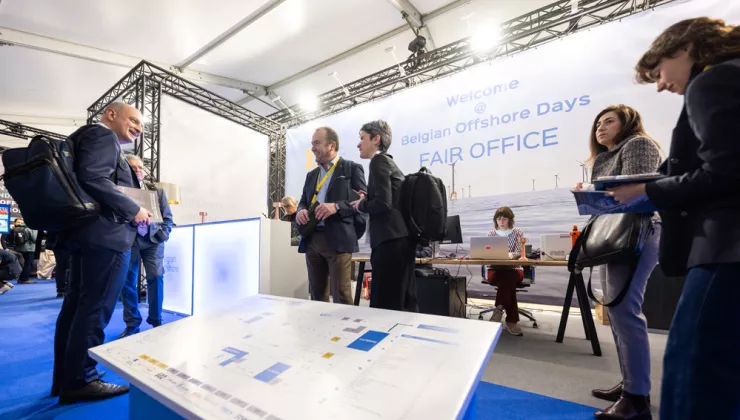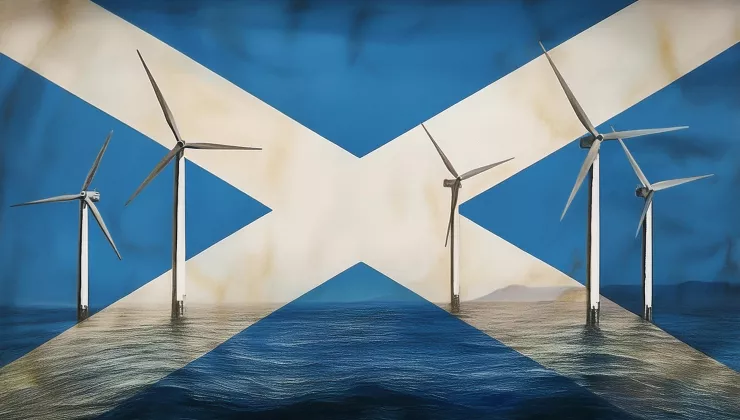Useful insights from WindEurope Annual Event 2025
WindEurope once again brought together key players in the European wind energy sector around a clear and powerful baseline: 'Scale up, Electrify, Deliver'. In a context of rising energy demand and increasing geopolitical pressure, the event provided a platform for innovative strategies to place wind energy at the heart of Europe's competitiveness and energy security.
One of the central themes was the electrification of industry and society, with wind energy as the engine for a sustainable energy system. Experts, policymakers and companies discussed how to accelerate the roll-out of wind capacity, with a strong emphasis on grid integration, digitalisation and cross-border cooperation. The potential of offshore wind was also discussed extensively.
The development of a robust supply chain was also high on the agenda. WindEurope 2025 emphasised that scaling up can only be achieved with a strong European manufacturing industry and a well-educated workforce. Investments in innovation, production capacity and training were therefore presented as essential building blocks.
Below you will find a concise summary of the main thematic sessions as well as an overview of the most important deals that were closed during WindEurope 2025 in Copenhagen. Enjoy the read!
All photos © WindEurope / Blue Cluster
Thematic sessions
During the three congress days, WindEurope 2025 offered a richly filled program with keynotes, panel discussions and thematic sessions. Prominent voices from policy, industry and research entered into a dialogue about the greatest challenges and opportunities for the wind energy sector.
Each day was dedicated to a specific theme, with concrete actions and collaborations as the central focus. Below we summarise the most important insights per day for you.
Day 1: Scape Up, Electrify, Deliver
The opening day went straight to the point: if Europe wants to achieve its climate goals, it needs to roll out wind energy much faster and smarter. Kadri Simson, EU Commissioner for Energy from 2019 to 2024, stressed that the EU may have ambitious plans, but that implementation is lagging behind.
Ministers from Denmark, Spain and Germany, among others, joined in and pointed out the bottlenecks: slow permitting, lagging grid capacity, and an industry under pressure. The message was clear: we don’t lack vision, but we lack decisiveness.
Call to Action
In the second part of the opening session, the wind energy sector launched the Copenhagen Call to Action, which outlines three specific steps to boost Europe's energy independence and competitiveness.
The three recommended measures are:
- Swift implementation of new EU licensing rules, so that more wind energy projects can be realised faster.
- Removing barriers to electrification, including through state support for renewable Power Purchase Agreements.
- Reducing investment risks through a stable stream of two-sided Contracts for Difference (CfD) auctions, which provide predictable revenues and lower capital costs.
This call comes at a critical time in a period of unprecedented economic uncertainty and is in line with the EU’s new Clean Industrial Deal, which puts electrification and the accelerated roll-out of renewables at the heart of European industrial policy.
While wind energy currently accounts for 20% of Europe’s electricity consumption, the EU aims for 35% by 2030 and more than 50% by 2050. Wind energy is seen as a local and stable energy source that contributes to energy security and reducing dependency on fossil fuels.
The European wind industry is currently investing more than €11 billion in new production capacity. However, construction of new wind farms is lagging behind due to slow permitting procedures, insufficient grid infrastructure, ineffective auction mechanisms and limited electrification.
Henrik Andersen, CEO of Vestas and Chairman of WindEurope, stressed that Europe is in a transition phase and that scaling up wind energy is necessary for sustainable, affordable and secure energy supply. He said the Copenhagen meeting is an important opportunity for governments and industry to jointly take concrete steps.
Panel discussion
During the subsequent panel discussion, Duncan Clark, Head of R&D Europe at Ørsted, stated that wind energy is currently facing challenges on several fronts. He believes there is an urgent need to remove existing barriers to the process. He also stressed the need to accelerate and reduce risk.
According to Clark, the past five years have been a testing period in Europe, in which different types and forms of tenders and incentives have been tested. Countries that focused on actually realising projects and reducing investment risks, such as the UK and Poland, have been most successful.
It was also emphasised that electrification needs to be accelerated to stimulate demand for renewable energy and reduce bottlenecks in the supply chain.
Javier Rodriguez Diez, Vice President at Vestas, added that both governments and industry need to urgently address the known problems with grid permitting and investment. It is a waste of resources to block grid system optimisation projects year after year.
Conclusion:
There is an urgent need for reliable and established procurement procedures, clear regulations and appropriate financial instruments to keep planned projects feasible.
Offshore wind energy is crucial for achieving the 2030 climate goals, but now requires clear policy choices and better coordination between countries and grid operators.
Day 2: Putting wind at the heart of Europe's competitiveness
The ministerial session at the start of day 2 focused on strengthening Europe’s competitiveness by putting wind energy at the heart of energy policy. As Europe continues to focus on the energy transition, the importance of strengthening the wind sector was emphasised not only from an environmental perspective, but also from an economic and strategic perspective.
Europe’s competitiveness and sustainability ambitions
The session was opened by Margrethe Vestager, EU Commissioner for Competition, who underlined the need for a stronger European industry in green technologies such as wind energy. According to Vestager, Europe must not only be the global leader in sustainable energy, but also the global leader in the production of the technologies that enable this transition.
She warns that if Europe leaves the production of wind turbines, batteries and other renewable technologies to other regions, such as Asia and the US, the economic benefits for the region would be lost.
Vestager also proposed the creation of a ‘European Wind Industrial Deal’, which would allow Europe to focus more on developing the necessary industrial infrastructure for wind energy. This would include measures to support local production, simplify tenders and improve access to risk capital for both large companies and SMEs in the sector.
The need for European industry and local production
The discussion continued with Christian Maaß, State Secretary of Germany, who stressed the importance for Europe not to be dependent on other markets for the production of wind turbines and their components. Germany is already working on plans to increase the production capacity of wind energy components, and Maaß proposed setting up a European collaboration to support innovation and production of wind technologies.
Christian Maaß: “We need to ensure that Europe doesn’t just buy clean tech, but builds it. We need to create the jobs and supply chains here in Europe.” Paula Pinho, Director of the European Commission’s DG Energy, added that the European Green Deal and the recovery plans after the COVID-19 crisis offer a great opportunity to strengthen the industry. She proposed creating a kind of ‘Clean Tech Alliance’, which would foster cooperation between Member States and companies so that the necessary infrastructure can be rolled out quickly.
Cross-border cooperation and investment
The subsequent panel debate made it clear that Europe’s energy infrastructure needs to be strengthened not only to support renewable energy generation, but also to maintain a competitive industry. Sven Utermöhlen, CEO of RWE Offshore, stressed that companies cannot invest in innovation and growth without certainty about policy and market conditions.
There was a call for stronger European cooperation in infrastructure development, in particular in the area of grid connections between countries. This would not only facilitate the production of wind energy, but also ensure lower costs through economies of scale. A coordinated approach to grid management, for example through a joint commitment to offshore systems, was also mentioned as a key priority.
Innovation and technology
The panel also placed great emphasis on the importance of innovation. Jan Kjaersgaard, CEO of GE Vernova Onshore Wind, indicated that it is important for Europe to maintain its technological lead by further investing in R&D for wind technologies and digital innovations. Strengthening European innovation capacity can not only contribute to lower costs for wind energy, but also position Europe as a global technology centre.
Conclusions and policy recommendations
Giles Dickson, CEO of WindEurope, concluded with a strong call to view Europe’s economic benefits from wind energy not only in terms of climate impacts, but also in terms of economic and industrial gains. Wind energy can be a key driver of European competitiveness, but only if the right framework conditions and policy measures are in place:
- European cooperation: Enhanced cooperation between Member States to ensure a coordinated approach to infrastructure, procurement and networks.
- Better support for industry: Creating a ‘European Wind Industrial Deal’ that enables companies to invest in local production capacity and improves access to risk capital.
- Fostering innovation: Investing in research and development of new technologies and further developing a knowledge and innovation hub in Europe.
- Stability of the investment climate: Creating a predictable and stable policy for investors, so that they have confidence to invest in the European wind sector in the long term.
Day 3: Getting offshore wind back on track
The third and final day of the WindEurope Annual Event was entirely dedicated to offshore wind energy. While this industry has long been considered the flagship of Europe’s energy transition, the tone has become considerably more realistic in recent months. Delays, cost increases and stranded tenders are causing unrest in the sector. At the same time, the urgency remains high: offshore wind must triple by 2030 if Europe wants to achieve its climate goals.
During the panel debate, Dan Jørgensen, European Commissioner for Energy and Housing, and government representatives from countries including the UK, the Netherlands and Norway, discussed the central question with CEOs of leading offshore developers: how do we get offshore wind back on track?
The financial reality
One of the major issues is the financial feasibility of projects. In recent years, tenders have been won at historically low subsidy rates. However, inflation, rising interest rates and high material costs have made many of these business cases unprofitable. Dan Lomholt of Ørsted pointed out the danger of excessive price pressure: “The market has changed, but many governments are holding on to old tender conditions. That is not sustainable if we still want to build.”
Belén Linares (Acciona Energía) also advocated more realistic tender models in which risks are shared between government and developer, for example through price indexation or safety nets in the event of exceptional market fluctuations.
Permits and planning: slow and fragmented
Offshore wind is technically complex, but the legal process is often the biggest hurdle. Permits take years and differ greatly between Member States. This not only complicates implementation, but also investment decisions.
Norwegian State Secretary Andreas Bjelland Eriksen advocated more European coordination: “We share the same sea, but we each plan and decide at our own pace. That no longer works.” He called for a coordinated planning approach, in which countries carry out joint environmental studies and coordinate zones.
Grid capacity: the invisible bottleneck
Another recurring bottleneck is the connection to the grid. While developers are planning increasingly large offshore parks, grid operators can barely keep up with the construction of infrastructure. In some cases, turbines are literally ready to be built, but the power output to land is not assured.
Giles Dickson, CEO of WindEurope, put it bluntly: “It is absurd that we can build a park at sea faster than the cable on land. This urgently needs to change.”
Rob Jetten, the Dutch Minister for Climate and Energy, also emphasized the importance of proactive planning: “Grid development should no longer be reactive. We need to anticipate, collaborate and make European agreements about who connects what where.”
Standardisation and industrialisation of turbine technology
Instead of rushing to new and ever larger turbine models, further industrialisation of existing turbine technology is essential to reduce the costs of offshore wind energy.
Marc Becker, Head of Offshore at Siemens Gamesa, said the industry already has the technology. Siemens Gamesa has received 1,000 orders for its 14-15MW offshore wind turbine, which is unique in the industry. This high demand has prompted the standardisation of all Siemens GA factories for the production of the associated blades and nacelles. By focusing on one proven platform, production can be scaled up and made more efficient, resulting in significant cost savings- possibly even more than anticipated.
Sven Utermohlen, Head of RWE’s Offshore Wind business, also supported this view. He emphasised that large installation investments, such as pile grippers, need to be reused more often to remain economically viable. However, this can only be achieved by extending the life cycles of product and further industrialising the production process. This creates a more sustainable and cost-efficient path for the growth of offshore wind.
Security and international cooperation in the North Sea
Several panellists stressed the importance of cooperation between the wind energy sector and the defence sector to ensure the safety of offshore installations. The need for standardised protocols and joint exercises to improve readiness was also discussed.
The North Sea is increasingly becoming a geopolitical issue. It is the heart of Europe’s offshore capacity, but also the basis for new international energy connections.
The EU, the UK and Norway all emphasise the need for cooperation, despite institutional differences after Brexit.
Graham Stuart, UK Secretary of State for Energy Security, stated that cooperation in the North Sea is “not a choice, but a necessity”. He referred to the North Sea Summits (Esbjerg, Ostend) as an example of how countries can make concrete agreements on interconnectors, environmental impact and capacity sharing.
Conclusion: a sector at a crossroads
The session ended with a clear call to policymakers: if Europe is serious about offshore wind, it must also take the preconditions seriously. That means:
- realistic, predictable tenders;
- fast, uniform permitting procedures;
- coordinated grid infrastructure; and
- collaboration on the protection of critical subsea infrastructure (CUI); and
- a long-term vision that looks beyond 2030.
Aurélie Beauvais, CEO of Euroheat & Power, summed it up sharply: 'We know exactly what is needed. Now it is a matter of daring to decide. The time of non-binding promises is over.'
Deals
The largest event in the wind energy sector naturally sees several deals being struck. Below is an overview of the most notable contracts signed at the WindEurope Annual Event:
- GE Vernova has signed an agreement with Forestalia to supply eight 6.1MW turbines for a 49MW wind farm in Spain, as part of a larger 693MW deal for projects in Aragon. This supports Spain’s target to install 62GW of wind energy by 2030.
- ScottishPower Renewables has appointed HSM Offshore Energy, recently acquired by Smulders, to build an offshore substation and foundation for the 960MW East Anglia 2 wind farm. Installation is set to start in 2027, and the project will power almost one million homes. The contract highlights the importance of early collaboration in the energy transition.
- Green Power Denmark and the Ukrainian Wind Energy Association (UWEA) have signed a cooperation agreement to contribute to the reconstruction of Ukraine’s energy infrastructure and strengthen energy security through wind energy. The cooperation includes knowledge exchange, training and study trips, with the aim of enabling a green transition. Ukraine aims for 24GW of renewable capacity by 2030.
- DEME has acquired Havfram for €900 million to strengthen its position in offshore wind energy. The acquisition, which will close by the end of April 2025, includes the integration of Havfram’s advanced vessels and expertise in turbine and foundation installation, strengthening DEME’s competitive position for future offshore wind projects.
- EirGrid, Enterprise Ireland and IDA Ireland have signed a Memorandum of Understanding (MoU) to develop the offshore wind sector in Ireland. It focuses on attracting investment, building a supply chain and achieving the target of 37GW of offshore wind energy by 2050. The MoU supports Ireland’s strategy to connect 5GW of offshore wind to the grid and to strengthen renewable energy production.
- Enercon and RWE have signed a letter of intent for a long-term cooperation on onshore wind projects in Europe. RWE will operate the wind farms, while Enercon will supply, install and maintain the turbines. The cooperation should provide both parties with greater planning certainty and contribute to a reliable roll-out of RWE’s growth programme in the European wind energy market.
See you in 2026
Would you like to be there (again) next year? Then be sure to note the following in your calendar:
WindEurope 2026 Annual Event
21-23 April 2026
IFEMA, Madrid (Spain)












